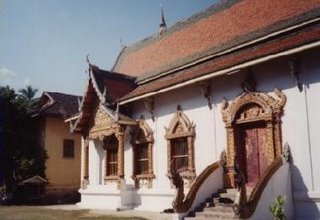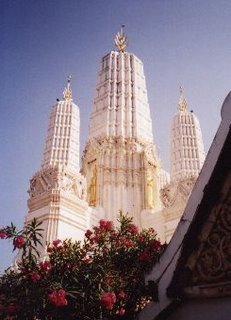Glossary of Thai Temple Terms (Part 2)
Naga
A Naga is a representation of a mystical serpent that according to the holy scripts sheltered the Buddha while he was meditating. In temple architecture, it runs down the edge of the roof, or, especially in Lanna (North of Thailand) temples, flanks the staircase that ascends to the Viharn or Bot. In sculptures, it is depicted sheltering the head of the Buddha with its own. Beautiful representations of Nagas are known from Khmer art, as found in the Khmer ruins in the Northeast of Thailand.
 Nagas on a Viharn in Wat Chiang Mun, Chiang Mai
Nagas on a Viharn in Wat Chiang Mun, Chiang Mai
 Prangs in Wat Mahathat, Petchaburi
Prangs in Wat Mahathat, Petchaburi
A Naga is a representation of a mystical serpent that according to the holy scripts sheltered the Buddha while he was meditating. In temple architecture, it runs down the edge of the roof, or, especially in Lanna (North of Thailand) temples, flanks the staircase that ascends to the Viharn or Bot. In sculptures, it is depicted sheltering the head of the Buddha with its own. Beautiful representations of Nagas are known from Khmer art, as found in the Khmer ruins in the Northeast of Thailand.
 Nagas on a Viharn in Wat Chiang Mun, Chiang Mai
Nagas on a Viharn in Wat Chiang Mun, Chiang MaiPrang
A Prang is an Ayuthayan or Khmer-style Chedi that is high and slim and looks like a vertical ear corn. Many of the Chedis in Wat Phra Kaew or Wat Po in Bangkok are Prangs.
 Prangs in Wat Mahathat, Petchaburi
Prangs in Wat Mahathat, PetchaburiSala
A Sala is an open-sided pavillion. Some Viharns are built in this style.
Viharn
A Viharn is a sermon hall. It is usually the busiest building in a Wat and open to everyone (provided the visitor behaves according to the temple etiquette!: you must be properly dressed, take off your shoes before entering a building and behave quietly) Just like the Bots, Viharns hold an altar and one or several Buddha images.
A Wat is a Thai Buddhist temple or monastery. In most cases it is not just one building, but a collection of buildings, shrines, and monuments within a courtyard that is enclosed by a wall.
Source : inm-asiaguides.com

















0 Comments:
Post a Comment
<< Home